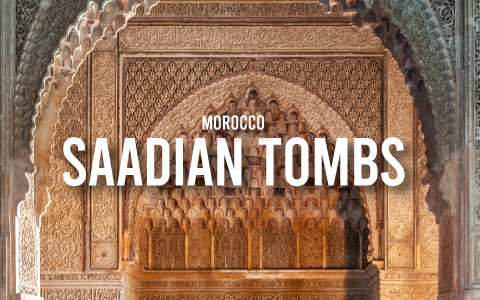
Unveiling the Majesty of History: Exploring the Saadian Tombs in Marrakesh
Marrakesh, a city that effortlessly weaves together the threads of tradition and modernity, conceals within its ancient walls a treasure trove of history and culture. One such hidden gem is the Saadian Tombs, a hauntingly beautiful testament to the opulence of Morocco’s past.
A Glimpse into the History of the Saadian Tombs
The Saadian Tombs, dating back to the 16th century, are the final resting place of members of the Saadian dynasty. The Saadians, a powerful Berber dynasty, rose to prominence in that era under Sultan Ahmad al-Mansur. This golden age of Moroccan history witnessed the flourishing of art, architecture, and culture, leaving an indelible mark on the city of Marrakesh.
Interestingly, the Saadian Tombs were lost to history for centuries. It was only in 1917 that they were rediscovered by chance when a French aerial survey revealed the hidden burial ground. Today, these tombs stand as an architectural marvel, showcasing the exquisite craftsmanship of Moroccan artisans during the Saadian era.
In recent years, efforts have been made to preserve and restore the Saadian Tombs, ensuring that future generations can continue to marvel at this historical treasure. The meticulous restoration work has garnered international acclaim, leading to the site’s inclusion in the UNESCO World Heritage List.
The Three Mausoleums
Upon entering the tombs, you are transported back in time. The site is divided into three main mausoleums – the Hall of Twelve Columns, the Hall of the Three Niches, and the Hall of Prayer. Each mausoleum is adorned with intricately carved stucco, colorful zellij tiles, and serene courtyards, creating a harmonious blend of artistry and spirituality.
The Hall of Twelve Columns: The Centerpiece of the Saadian Tombs
As the name suggests, the hall is adorned with twelve marble columns that support a delicate cedarwood dome. The walls are adorned with intricate carvings and inscriptions from the Quran, adding a spiritual aura to the space. The tombs of various Saadian princes and members of the royal court are laid to rest in this majestic hall.
The Hall of the Three Niches: A Tranquil Atmosphere
Adjacent to the Hall of Twelve Columns, the Hall of the Three Niches is a smaller chamber. With its three elegantly decorated arches, it houses the tombs of Saadian princes and other esteemed individuals. The careful placement of the graves reflects the hierarchical structure of the Saadian dynasty, providing insight into the social order of the time.
The Hall of Prayer: The Mausoleum of Sultan Ahmad al-Mansur
The Hall of Prayer is the final resting place of the illustrious Sultan himself. This sacred space features a mihrab, or prayer niche, indicating its significance as a place of worship. The walls are adorned with vibrant tiles and inscriptions, creating a visual spectacle that speaks to the opulence of the Saadian era.
Visiting the Saadian Tombs
For those seeking to immerse themselves in Morocco’s past, a visit to the Saadian Tombs is a must. The site is conveniently located within the Kasbah district of Marrakesh, making it easily accessible for tourists and history enthusiasts alike. The entrance fee is nominal, offering excellent value for the experience of exploring this architectural marvel.
Tips for Organizing a Visit:
- The Saadian Tombs are open daily from 9 am to 5 pm. To avoid crowds and fully appreciate the serenity of the site, consider visiting early in the morning or late in the afternoon.
- Engage a knowledgeable local guide to enhance your experience. They can provide insights into the historical significance of the tombs and share captivating stories about the Saadian Dynasty.
- As a place of historical and religious importance, it’s essential to dress modestly when visiting the Saadian Tombs. Both men and women should cover their shoulders and knees as a sign of respect.
- While photography is generally allowed, be mindful of your surroundings and fellow visitors. Avoid using flash, and be respectful of any signage indicating restricted areas for photography.
- Make the most of your visit by combining it with nearby attractions such as the Kasbah Mosque and the vibrant Jardin Majorelle. And don’t forget to visit the Medina and Jemaa el-Fnaa. This allows for a comprehensive exploration of Marrakesh’s rich cultural heritage.
The Saadian Tombs in Marrakesh are more than just a collection of burial chambers; they are a portal to a bygone era of splendor and cultural richness. As you weave through the intricate halls, you are met with a profound sense of history and spirituality.



